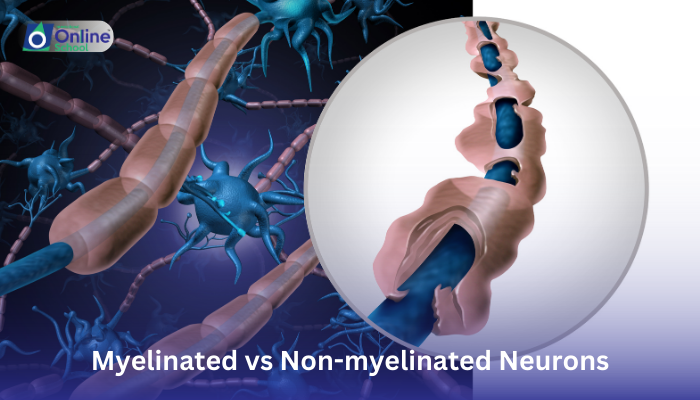
Learning Outcomes:
i. Differentiate between myelinated and non-myelinated neurons based on their structure and function.
ii. Explain how the presence or absence of myelin affects the speed of nerve impulse transmission.
iii. Understand the advantages and disadvantages of each neuron type in different parts of the nervous system.
Introduction:
Imagine a message racing through the bustling city of the nervous system. Some messages, like a fire alarm's shrill cry, demand immediate action and swift transmission. Others, like the gentle breeze whispering through leaves, can take their time. But how does the nervous system handle this diverse range of messages? The answer lies in the insulation of its communication wires – the neurons. In this lesson, we'll explore the fascinating world of myelinated and non-myelinated neurons, discovering how their structure influences the speed and efficiency of nerve impulse transmission.
i. The Myelin Mystique: Speedy Signals in Wrapped Axons
Myelinated neurons are like the city's express lanes, boasting axons wrapped in a fatty layer called myelin. This myelin sheath acts like a high-quality insulator, preventing the electrical signal from leaking out as it travels down the axon. Imagine wrapping a hot cup of coffee with several layers of insulation – the heat stays trapped inside, just like the electrical signal remains focused within the myelinated axon. This focused transmission allows myelinated neurons to send signals much faster, reaching speeds of up to 120 meters per second! Think of reflexes, where a sudden touch triggers an immediate withdrawal – the lightning-fast response is thanks to the efficiency of myelinated neurons.
ii. The Bare Axon Warriors: Slower Messages, Precise Delivery
Non-myelinated neurons, on the other hand, are like the city's slower, winding backstreets. Their axons lack the myelin insulation, leaving the electrical signal exposed as it travels. This slower transmission, at around 1-2 meters per second, might seem inefficient, but it has its advantages. Imagine a message needing to reach every house on a particular street – the slower pace of the non-myelinated neuron allows for a more precise and targeted delivery, ensuring the message reaches its intended destination. Non-myelinated neurons are especially important in areas like pain perception, where a slow, nuanced signal allows us to pinpoint the source and intensity of the discomfort.
iii. Finding the Right Balance: Matching Neurons to the Task
The choice between myelinated and non-myelinated neurons is not random. The nervous system carefully selects the right type for each task:
Myelinated neurons: Used for rapid transmission of urgent signals, like reflexes and sensory inputs requiring quick reactions.
Non-myelinated neurons: Used for slower, more precise signaling, like pain perception, autonomic control (breathing, digestion), and certain aspects of smell and taste.
Myelinated and non-myelinated neurons, with their distinct structures and speeds, are like the diverse lanes in the nervous system's communication network. Myelinated neurons, the speed demons, ensure rapid responses to critical situations, while non-myelinated neurons, the slowpokes, deliver precise messages where accuracy takes precedence over speed. By understanding this fascinating interplay, we gain a deeper appreciation for the remarkable efficiency and adaptability of the nervous system, constantly optimizing its communication channels to meet the demands of our ever-changing environment. So, the next time you blink an eye, feel a prick of pain, or react to a sudden sound, remember the silent heroes within your nervous system, the myelinated and non-myelinated neurons, working in perfect harmony to keep you informed, protected, and connected to the world around you.